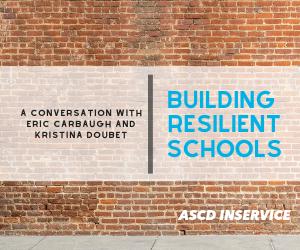By Margaret Wilson, Great Minds
I once taught a kindergarten student who was convinced he couldn’t succeed at school tasks. During the first few weeks of school, even the simplest assignment could lead him to tearfully shout, “I can’t do it!” Once, when working on writing his first name from a model, he threw down his dry erase board and said, “I am just not good at writing. I can’t do it!”
Researcher Carol Dweck calls attitudes like this student’s a fixed mindset—a belief that our abilities are innate and unchangeable. On the flipside is the growth mindset—a belief that through effort and perseverance, we can improve our performance in a given area.
An increasing body of research demonstrates the importance of having a growth mindset to student success. As Tenelle Porter of the University of California at Davis explains:
Students who embrace the growth mindset are likely to act in ways that promote their learning and growth, even if that means taking risks: they will seek out challenges to help them learn, be more effortful and persistent when material is difficult because they believe it’s possible to improve and show resilience – when inevitable setbacks come in school, they can bounce back.
Here are six ways to help students develop a growth mindset.
- Understand the importance of productive struggle. Developing a growth mindset requires taking on and ultimately succeeding with challenging tasks. It can be easy to think that students’ confidence is bolstered by doing tasks that are easy for them. It’s also tempting to step in and either remove a task or do work for students at the first sign of a problem. However, true learning requires some struggle. And learning to work through challenges is what ultimately fosters confidence and a growth mindset.
- Teach a rigorous curriculum. Adopting a rigorous, high-quality curriculum is a key step in ensuring that all students have the chance to engage in productive struggle. Used over time, an engaging, rigorous curriculum helps students believe that through deep thinking, analysis, and perseverance, they have the capacity to succeed academically.
- Create a learning environment in which students feel comfortable making mistakes. Students need to see mistakes not as a sign that they cannot succeed but instead as a chance to learn. Foster a community in which classmates are respectful when someone makes a mistake. Ensure that you respond to mistakes as teachable moments, not signs of deficit. For example, if a student misreads a word problem in math, use it as an opportunity to teach skills like rereading, highlighting key words, and clarifying what a question is asking, rather than just marking the answer wrong, which primarily signals failure to students.
- Scaffold so that all students can be successful with rigorous tasks. While productive struggle is valuable, sometimes students can struggle too much or unproductively. Such unproductive struggle can lead them to develop a fixed mindset, believing they just aren’t good at a particular subject or type of work. Look for signs of undue frustration or wasted effort and support students, not by removing the task or making it easier, but by removing obstacles to their success or helping them find another path to complete a task. For my student who struggled to write his name, I suspected that he might have been overwhelmed by how many letters he saw at once. I modified the task by cutting it up and having him write one letter at a time.
- Give students feedback on their learning histories. In his book Choice Words, Peter H. Johnston gives teachers a wealth of ideas for how to use language to shape students’ positive beliefs about themselves as learners. One way is to describe students’ “learning histories.” Pointing out the progress children have made in social, emotional, or academic areas helps them see that learning is not a fixed condition but a process. It can highlight how students’ efforts and perseverance have led to success. You can share learning histories with a whole group: “Remember the beginning of the year when we struggled to agree and disagree respectfully in conversations? You just did it effortlessly in that Socratic Seminar!” Or, you might share a learning history privately with an individual student: “I’ve noticed that in your writing, you have learned how to explain why the evidence you selected matters. Your elaboration makes it much easier for readers to follow your argument.” This strategy is even more powerful when we ask students to analyze the reasons for their progress (“What helped you learn to agree and disagree respectfully?”)
- Model a growth mindset. It can be powerful for students to see what a growth mindset looks like in action. As you encounter challenges, use the language of growth: “I haven’t figured out how to use this new technology yet, but I know that when I do, it’s going to be great for our classroom.” Avoid fixed mindset language like, “I’ve never been good at math either” or “I am just not one of those people who is good at cooking.”
Developing a growth mindset can take time. My kindergarten student continued to struggle with self-doubt throughout the school year, but slowly, with the use of these and other strategies, he made progress. When near the end of school, I pointed out that he could now write a complete paragraph and reminded him of his struggles with writing earlier in the year, he laughed, saying, “I was so silly then! Now I love writing!”
Margaret Wilson is the author of the book The Language of Learning: Teaching Students Core Thinking, Listening, and Speaking Skills. She is also managing editor of Humanities Content Development at Great MindsÒ, the curricula creator of EngageNY Math/Eureka Mathä, Wit & WisdomÒ, and PhD Scienceä. The learning design of Great Minds curricula empowers teachers and students to achieve a growth mindset through its embedded tools and scaffolds. To learn more, visit greatminds.org.








